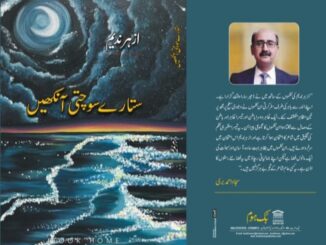
Zafar Iqbal, poet of insistence of disavowal
by, Meraj Rana
One of the reasons for the fizzle of Urdu criticism has been that it reiterates the points about literature and poetry that have been stated before. One of the curses of Urdu literary criticism is that if a great critic of Urdu calls a poet great, then all the critics after him call the concerned poet great so many times that his poetic personality seems to feel small. And if by slipup the great critic shifts his initial view about the poet concerned, all ensuing critics promptly change their opinions about the poet like political parties. This proves that both contemporary criticism and critics have no firm or strong literary belief.
Zafar Iqbal is perhaps the only poet in the modern poetic tradition of Urdu whom Urdu criticism has proved to be both great and insignificant. But the truth is that Zafar Iqbal’s poetry is a fine expression of modern sensibilities while being concatenated to the classical tradition. No one can deny the fact that Zafar Iqbal,(1932) a conspicuous notability in coeval Urdu literature, is extolled for his unique contribution to modern Urdu poetry.
His literary journey quantifies several decades, characterized by an ingenious style that emulsions traditional Ghazal form with modernist themes. His work “Aab-i-Rawan” (Flowing Water) has been indispensable in reassuring Urdu poetry, making it pertinent to coetaneous readers while retaining its classical sum and substance. One of the totems of Zafar Iqbal’s poetry is his capability to immaculately incorporate modernist sensibilities with traditional forms.
The Ghazal, a poetic form known for its precise structure and themes of love and mislaying, is overriding to Iqbal’s work. However, he inculcates this traditional form with modern themes such as existential torment, social disservice, and the intricacies of conterminous life. This emulsion not only conserves the comeliness of classical Urdu poetry but also makes it intelligible and congenial to modern readers.
آنکھ کے ایک اشارے سے کیا گُل اُس نے
جل رہا تھا جو دیا اتنی ہوا ہوتے ہوئے
The above couplet of Zafar Iqbal is predicated on the classical tradition, but both its connotation and locution of expression are subject to modern sensibilities. We know that in classical Persian and Urdu poetry, there are many examples of the metaphor of the lover’s eye creating multiple attributes. This couplet by Zafar Iqbal also describes the figure created by the metaphor of the eye, but the created figure does not have any semantic relationship with classical poetry. However, the complete semantic world of this couplet creates itself without any previous reference. This means that the semantic figures of the couplet are self-contained in themselves as well as revealed by the situation of their time. Eye, wind and lamp are three basic metaphors in this couplet which are prominent with their respective characteristic figures. It means that light from lamp and darkness from light, noise and destruction from air and light and glory from eye are prominent.
However, lamp here is not only a metaphor for a lover but also a powerful symbol of contemporary resistance. In the same way, here the eye can also be of the beloved and this eye is also a metaphor for the negative power of establishment. From the close reading of the couplet, the meaning emerges that the position of the poet is like that of a lamp that was bright even in the strong wind. That is, it was beyond the destructive power of the wind to extinguish it. The common belief is that a strong wind extinguishes the lamp, but Zafar Iqbal rejects this general attitude and has attributed its extinguishing to a gesture of the eye. Here the allusion of the eye can be associated with the beloved and also with contemporary power. Iqbal’s use of language is incredibly noteworthy. He makes use of a loquacious tone that breaks away from the desperately Persianized diction traditionally associated with Urdu poetry. This stylistic predilection makes his work more attainable, letting him to come to grips with complex themes in a candid manner. His Ghazals often feature quotidian language, yet they are opulent with layers of meaning and dodgy nuances.
پیاس رکھتی ہے تازہ دم مجھ کو
دھوپ میں اور لہلہاتا ہوں
In this couplet, the prevailing notions were also refuted. Commonly associated with thirst is restlessness and depression with sunlight. But here both thirst and sunlight are mentioned as the cause of refreshment. And this contradictory quality has been created in the couplet because its perspective has changed.
With this change, both the words thirst and sunlight are transformed into moving metaphors and create completely new meanings in the couplet. That is, thirst becomes a metaphor for curiosity and becomes the reason for the poet’s revitalization. A relationship of Zafar Iqbal’s poetic attitude is connected with this couplet of Ghalib:
رنج سے خُوگر ہوا انساں تو مٹ جاتا ہے رنج
مشکلیں مجھ پر پڑیں اتنی کہ آساں ہو گئیں
Iqbal’s poetry is an esoteric probing of human emotions and social issues. His work caverns into themes such as love, misplacement, individuality, and the human condition. However, unlike many of his predecessors, Iqbal’s treatment of these themes is utterly contemplative and often pronounced by a sense of disenchanted and distrust.
جو برسوں میں ہوا کرتا تھا پہلے
یہاں برسوں سے اکثر ہو رہا ہے
This couplet refers to a major event that occurs once in years. That is why the incident was very important. But the same incident has been happening here regularly for years now, so that incident has now become part of our daily life. Therefore, no one is surprised by this incident. Here the social apathy is highlighted by the satirical style of the poet.
یہ میری آگ ہے، لیکن دھواں میرا نہیں ہے
بیاں میرا سہی رنگِ بیاں میرا نہیں ہے
In this couplet of Zafar Iqbal, the quality of perfection has been created by the simplicity of words. By describing his statement as fire, the poet expresses that the smoke rising from it means that the poet’s style of expansion and promotion of his statement or thought is not his own. Therefore, it can be said that in the couplet, the poet does not only describe his intellectual unity, but also shows the greatness of that poetic unity.
In his investigation of love, for instance, Iqbal moves beyond the rhapsodic notions commonly found in traditional ghazals. His rendering of love is often brimming with complexity and opacity, mirroring the factuality of modern relationships. This approach not only rejuvenates the theme but also reverberates with contemporary readers who may ascertain traditional depictions of love unduly simplistic .For example, these couples of Zafar Iqbal can be seen:
میں زیادہ ہوں بہت اس کے لیے اب تک بھی
اور میرے لیے وہ سارے کا سارا کم ہے
مجھ سے چھڑوائے مرے سارے اصول اس نے ظفر
کتنا چالاک تھا مارا مجھے تنہا کر کے
میرے آثار چمکتے ہیں ظفر چاروں طرف
کتنا آباد ہوا جاتا ہوں ویراں ہو کے
Zafar Iqbal’s first couplet describes the dispositions of both the lover and the beloved. In the eyes of the beloved, the existence of the lover is greater, while for the lover, the existence of the beloved is lesser. Here the more and less of existence is related to our classical poetics. In classical poetics, the lover is portrayed by his relinquish and the beloved (due to multiple lovers’ intercession) is characterized by self-worth. There is also a meaning in the couplet that a little act of the lover is more known to the beloved, while the lover knows less of the complete existence of the beloved. Therefore, the poet looks forward to accepting the beloved’s existence with further evolution. Which is confirmed by the surprising tone of the couplet.
Similarly, in the second couplet, the deception of the beloved and the simplicity of the lover have been described. Here the consequence of conditional love is described. It means that first the lover separated his lover from all his principles and then left him at the same place where the conditional love started. It is obvious that in such a situation the lover does not see any other way to accept the conditions of the beloved which is the cause of the death of the poet. Here, it is not a pity that the poet died, but it is more a rejection that the beloved killed him by separating him from his principles.
Zafar Iqbal’s third couplet is a manifestation of the zenith of his poetic thought and art. In this couplet, he has created a colossal world of meaning by connecting the brilliance of the past with the despair of the present. The word remnants in the couplet is not only an indication of a glorious past, but also a metaphor for insignificance. And with this metaphor, the poet describes the fragmentation of his existence. That is, he sees the signs of existence gleaming everywhere. The radiant of the signs here is actually the crowd of people turning towards it. If we settle on this point, then the first meaning of the couplet is that the existence of the poet or the lover did not matter as long as he was composed.
The second meaning turns out to be that the value of a true being is the cause of its subsequent value. The third meaning is that the existential fragmentation of the poet, i.e. his desolation, is actually the source of his settlement. Similarly, in these couples of Zafar Iqbal, the collective meaning of the individual experience of love is prominent:
مسکراتے ہوئے ملتا ہوں کسی سے جو ظفر
صاف پہچان لیا جاتا ہوں رویا ہوا میں
ٹکٹکی باندھ کے میں دیکھ رہا ہوں جس کو
یہ بھی ہو سکتا ہے وہ سامنے بیٹھا ہی نہ ہو
میں ہی معدوم سا ہوتا گیا رفتہ رفتہ
ورنہ منظر تو فلک بوس رہے چاروں طرف
The biggest objection to modernism was that it had severed the relationship of literature and poetry from society. This is not the occasion to denounce the nescience of this non-essential objection but to explain that no literature or poetry is created in a vacuum. Behind the emergence of literature and poetry, there must be a driving force of their social consciousness somewhere in the individual experience of writers and poets. In this whole problem, the question is about the intelligence that can discover this hidden consciousness. Zafar Iqbal’s poetry is not confined to personal emotions and experiences; it also serves as a medium for social and political commentary. He is acutely aware of the socio-political landscape of his time, and his work frequently addresses issues such as political corruption, social injustice, and the plight of the marginalized.
آزمائش میں ہی رکھتا ہوں سدا خود کو ظفرؔ
میری مشکل ہی سرا سر مری آسانی ہے
یہی پانی ہے کائنات میری
اسی میں ڈوبتا، ابھرتا ہوں
ضائع ہوتی ہے میری ہر کوشش
کہیں پورا نہیں اترتا ہوں
ٹوٹ پڑتی ہے قیامت کوئی پہلے ہی ظفرؔ
قصد کرتا ہوں جو فتنے کو جگا دینے کا
جھوٹ بولا ہے تو قائم بھی رہو اس پر ظفرؔ
آدمی کو صاحبِ کردار ہونا چاہیے
ڈرتا ہوں پھر کہیں سے نکالیں نہ سر ظفرؔ
میں اس کو اپنے ساتھ ڈبونے کے باوجود
یہ حرف و صوت کرشمے ہیں سب اسی کے ظفرؔ
لہو کے ساتھ رگوں میں جو ڈر رکا ہوا ہے
In these couplets, the sneaky expression of the external situation affecting the internal existence is prominent, due to which the mentioned couplets have been utterly defended from the curse of flat narrative unlike progressive poetry.
Perhaps this is the reason that in them the existence of meaning is created by the disappearance of the subject.However, it can be said that Iqbal’s social critique is both direct and nuanced. He uses metaphor and allegory to comment on the condition of society, often accenting the discrepancy between the ideal and the real. His poems challenge the status quo and encourage readers to reflect on their roles within a crippled system. This aspect of his poetry substantiates his dedication to using poetry as a tool for social change.
Zafar Iqbal is often credited with bringing a fresh, innovative approach to Urdu poetry. His experiments with form and style have expanded the boundaries of what is considered possible within the genre. He is known for his unconventional use of meter and rhyme, often breaking away from the rigid structures of traditional ghazals to create a more fluid and dynamic poetic experience. Iqbal’s concoction is also putative in his thematic choices. While he respects the traditions of Urdu poetry, he is not scared to push the envelope, coming to grips with forbidden subjects and challenging societal norms. This valiant approach has earned him both applause and criticism but has indisputable emplaced him as a predominant poet in modern Urdu literature. A tectonic aspect of Zafar Iqbal’s poetry is his virtuoso use of language and imagery. His couplets are often characterized by picturesque, reminiscent imagery that brings his themes to life. Whether he is describing the beauty of nature, the tingle of loss, or the intricacies of human relationships, Iqbal’s imagery is both striking and indelible.
His language, while unadorned and talkative, is infused with depth and complexity. Iqbal’s ability to convey recondite truths through ostensibly linear language is one of his greatest strengths as a poet. This artistry not only makes his poetry intelligible but also ensures that it echoes on quite a few levels with readers. While Zafar Iqbal’s contributions to Urdu poetry are widely recognized, his work has also faced criticism. Some traditionalists argue that his departure from classical forms and themes undermines the essence of Urdu poetry. Others, however, praise his innovative approach, seeing it as a necessary evolution to keep the genre relevant in modern times.
Iqbal’s bequest is an evidence to his impact on Urdu poetry. He has inspired a new generation of poets to experiment with content, promising them to find their own voices rather than adhering strictly to tradition. His poetry has also played a crucial role in bringing Urdu poetry to a broader audience.




